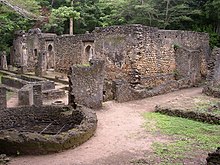Gedi
Gedi (also Gede ) is a ruined city on the east coast of Kenya and is located about 16 kilometers south of Malindi .
From the 9th century onwards, a number of important trading cities emerged on the east coast of Africa, trading on the one hand with the countries on the Indian Ocean and on the other hand with the hinterland.
Gedi is five kilometers from the sea and was therefore probably less involved in sea trade. It was much smaller than Kilwa Kisiwani , yet it was a wealthy city. The ruins of the coral limestone houses are still very well preserved and are considered a prime example of East African architecture. They were covered with a thick layer of plaster on the outside and a thinner layer on the inside. The city was founded relatively late. The oldest remains are dated to the end of the 13th or beginning of the 14th century. The city flourished in the 15th century. In the early 16th century, when the Portuguese conquered the coastal cities, the city was temporarily abandoned. Oromo , themselves attacked by Somali , had advanced southwards beyond Gedi and almost to Mombasa . They triggered an escape movement. Many of the refugees came to Gedi, which experienced another brief period of prosperity. The city was finally abandoned at the beginning of the 17th century. In the Oromo language Gedi means "precious", according to European maps of the 17th century the place was called Kilimani at that time .
In the 15th century the city had an area of 20 hectares and was surrounded by a 2.5 meter high wall. Since 1948, James Kirkman, the pioneer of East African archeology on the coast, has excavated a Friday mosque, a palace, several smaller mosques, 14 stone houses and a tomb that can be dated to 1399 by an inscription. The mosque of the long canal had two pillars in the middle that blocked the view of the mihrab . Other mosques had two rows of pillars supporting the roof domes. The entrances to the prayer rooms were on the longer side walls. The fountain for the ritual ablutions was outside the mosque area, because it also served to supply the district with drinking water.
From the 15th century it was common to embed Chinese plates as decorative motifs in plastered walls. In contrast to those in other coastal cities, the houses were only one-story. The second settlement in the 16th century took place within a lower wall in a smaller urban area.
The place is now a popular destination for tourists.
literature
- Rudolf Fischer: Coral Cities in Africa. The pre-colonial history of the east coast. Edition Piscator, Oberdorf 1984, pp. 107-121
- James Kirkman: Gedi. Historical monument. Trustess of Kenya Museum, Nairobi 1975 (tourist guide)
- James Kirkman: Gedi, the palace. Studies in African history, Mouton, Den Haag 1963
- James Kirkman: The Arab City of Gedi. Oxford University Press, Oxford 1954
Web links
- Gedi Ruins, Kenya - Explanation, Facts And History. African mecca
- Gedi, une cité islamique médiévale du Kenya. France Diplomatie French excavation report
- Archnet, the great mosque
- Archnet, the palace
Coordinates: 3 ° 19 ′ S , 40 ° 1 ′ E

